Insurgency in North-East- 2 | 1 Year Preparation for UPSC CSE PDF Download
Nagaland:
The Nagas were the inhabitants of the Naga hills along the Northeast frontier on the Assam-Burma border. They numbered nearly 500,000 in 1961, constituted less than 0.1% per cent of India’s population, and consisted of many tribes speaking different languages.
How old is the Naga political issue?
- The British annexed Assam in 1826, and in 1881, the Naga Hills too became part of British India. The first sign of Naga resistance was seen in the formation of the Naga Club in 1918, which told the Simon Commission in 1929 “to leave us alone to determine for ourselves as in ancient times”.
- In 1946 came the Naga National Council (NNC), which, under the leadership of Angami Zapu Phizo, declared Nagaland an independent state on August 14, 1947.
- The NNC resolved to establish a “sovereign Naga state” and conducted a “referendum” in 1951, in which “99 per cent” supported an “independent” Nagaland.
When did the armed movement begin?
- On March 22, 1952, Phizo formed the underground Naga Federal Government (NFG) and the Naga Federal Army (NFA). The Government of India sent in the Army to crush the insurgency and, in 1958, enacted the Armed Forces (Special Powers) Act.
When did the peace efforts start?
- Almost simultaneously with the resistance. On June 29, 1947, Assam Governor Sir Akbar Hyderi signed a 9-point agreement with moderates T Sakhrie and Aliba Imti, which was almost immediately rejected by Phizo.
- The Naga Hills, a district of Assam, was upgraded to a state in 1963, by also adding the Tuensang Tract that was then part of NEFA.
- In April the next year, Jai Prakash Narain, Assam Chief Minister Bimala Prasad Chaliha and Rev. Michael Scott formed a Peace Mission, and got the government and NNC to sign an agreement to suspend operations that September. But the NNC/NFG/NFA continued to indulge in violence, and after six rounds of talks, the Peace Mission was abandoned in 1967, and a massive counter-insurgency operation launched.
When did the NSCN come into being?
- On November 11, 1975, the government got a section of NNC leaders to sign the Shillong Accord, under which this section of NNC and NFG agreed to give up arms.
- A group of about 140 members led by Thuingaleng Muivah, who were at that time in China, refused to accept the Shillong Accord, and formed the National Socialist Council of Nagaland in 1980.
- In 1988, the NSCN split into NSCN (IM) and NSCN (K) after a violent clash. While the NNC began to fade away, and Phizo died in London in 1991, the NSCN (IM) came to be seen as the “mother of all insurgencies” in the region.
What did the NSCN (IM) want?
A “Greater Nagalim” comprising “all contiguous Naga-inhabited areas”, along with Nagaland. That included several districts of Assam, Arunachal and Manipur, as also a large tract of Myanmar. The map of “Greater Nagalim” has about 1,20,000 sq km, while the state of Nagaland consists of 16,527 sq km. The claims have always kept Assam, Manipur and Arunachal Pradesh wary of a peace settlement that might affect their territories. The Nagaland Assembly has endorsed the ‘Greater Nagalim’ demand — “Integration of all Nagainhabited contiguous areas under one administrative umbrella” — as many as five times: in December 1964, August 1970, September 1994, December 2003 and as recently as on July 27, 2015.
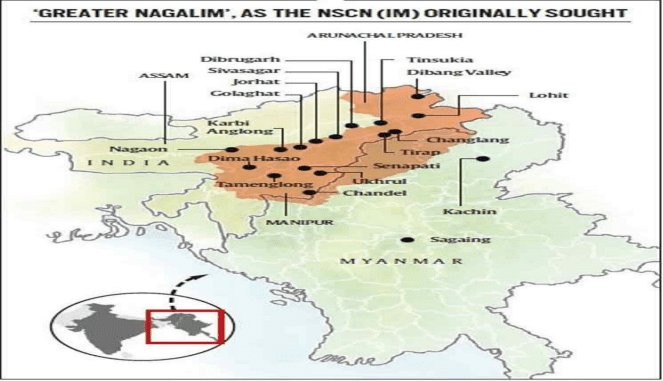
When did NSCN (IM) join peace talks?
The Government of India signed a ceasefire agreement with NSCN (IM) on July 25, 1997, which came into effect on August 1, 1997. Over 80 rounds of talks between the two sides were held subsequently.
Naga Peace accord 2015:
- Nagaland peace accord is the accord signed in August 2015 by the Government of India and the National Socialist Council of Nagaland (NSCN) to end the insurgency
- The framework agreement is based on the "unique" history of Nagas and recognising the universal principle that in a democracy sovereignty lies with the people.
- National Socialist Council of Nagaland (NSCN) has given up its demand for ‘Greater Nagaland’ and vowed allegiance to the constitution of India. The details of the accord are yet to come in public domain.
- Government of India has also made clear that existing boundaries of states will not be altered.
- It will restore peace and pave the way for prosperity in the North East.
- It will advance a life of dignity, opportunity and equity for the Naga people, based on their genius and consistent with the uniqueness of the Naga people and their culture and traditions.
- The Government of India recognized the unique history, culture and position of the Nagas and their sentiments and aspirations. The NSCN understood and appreciated the Indian political system and governance.
How have Manipur, Assam and Arunachal Pradesh reacted?
Leaders cutting across party lines have preferred to wait and watch. Nobody in these three states would allow even an inch of their land to be added to a ‘Greater Nagalim’, if at all that term is part of the accord.
What about S S Khaplang?
In March 2015, he abrogated the ceasefire he had signed in 2001, and is sure to oppose the accord. Security forces have been already alerted across Nagaland, Assam, Manipur and Arunachal Pradesh.
TRIPURA:
- Insurgency in Tripura finds its root in the influx of refugees from the newly emerged East Pakistan after partition, post independence and post 1971 war liberation in Bangladesh.
- Migration fuelled discontent and demographic inversion in Tripura.
- The ratio of population of tribals and non-tribals which was 70:30 at the time of independence in 1947 changed to 70: 30 in favour of non tribals.This injustice has led to insurgency.
- The evolution of insurgency in Tripura can be traced to the formation of the Tripura Upajati Juba Samiti (TUJS) in 1971, followed by the Tripura National Volunteers (TNV) in 1981.
- The National Liberation Front of Tripura (NLFT) was formed on March 2, 1989 and its armed wing, the National Holy Army and All Tripura Tiger Force (ATTF), in July 1990, queering the pitch.
- The two outfits came up with a secessionist agenda, disputed the merger of the kingdom of Tripura with the Indian Union, and demanded sovereignty for Tripura, deportation of “illegal migrants,” the implementation of the Tripura merger agreement and the restoration of land to the tribal people under the Tripura Land Reform Act, 1960.
- Between 1990 and 1995, the insurgency remained low-key.
- But it grew in extent and magnitude between 1996 and 2004 — and then started melting.
How Tripura succeeded in controlling insurgency: Tripura model
The State took on the problems in a strategic and resolute manner under the sagacious and visionary leadership of Chief Minister Manik Sarkar. It formulated a multi-dimensional and fine-tuned construct to respond creatively to the situation. It consisted of following:
- Counter-insurgency operations intent on swift area-domination and ascendancy
- Psychological operations and confidence-building measures
- Accelerated development thrust
- Management of the media
- Civic action programmes of the security forces
- Political processes
Counter insurgency operations (C.I.Ops):
- C.I.Ops, potent instrument in any fight against insurgency, formed the core of the interventions. These were not set as exclusive, hawkish, one-dimensional combat in the nature of conflict-management. The combat was invested with a broader meaning and constructive contents in the nature of a productive conflict-resolution aimed at defusing insurgency.
- Remarkably, the counter-insurgency operations, intensive, extensive and covert as they were, did not take the Army on board — as had happened in other insurgency-bound States. Only the Central paramilitary forces and State police forces were drafted.
- Special Police Officers (tribals included) were inducted and channelled into the operations. This proved to be valuable in terms of gathering intelligence and keeping a tab on the activities and movements of the insurgents, collaborators and harbourers.
- The Central and State security forces were forged into a synergetic, coordinated and cohesive mode to derive optimal gains. Their conduct was under close observation at the highest level (including at the level of the Governor and the Chief Minister), in order to check personnel from going berserk and being ruthless, trigger-happy, oppressive and violative of human rights.
- This paid off: no complaint of human rights violation. No antipathy against the security forces or the establishment surrounded the minds of citizens.
Psychological operations and confidence-building measures along with Media Management :
- Psychological interventions were focussed on correcting the tribal person's negative perception about the state and the mainland, and inducing confidence in and credibility about the State's intentions.
- Psychological operations were forged to work on the minds of the target group — for all conflicts, big or small, begin in the human mind. Brainstorming sessions centred on unwinding the deeds, misdeeds and subversive designs of insurgency and to unmask its hypocritical conduct, promotion of monetary interests, the lavish lifestyle of the leaders in contrast to the abject living conditions of the rank and file, sexual exploitation of women cadre, forced induction of adolescents into the outfits and a game plan to keep the region in perpetual backwardness.
- This strategy was carried through the media, both print and electronic, art groups, intellectuals, and interactive seminars and discussions.
- Confidence-building exercises and healing touches encompassed special recruitment to the security forces and other government services, especially in the insurgency-bound pockets. The provision of jobs to tribals in particular, and to the family members of victims, attractive rehabilitation packages comprising monetary benefits, and vocational training to induce insurgents to return to the mainstream and earn a peaceful living and decent livelihood, were other features.
- The Governor and the Chief Minister, in the course of their public programmes, sought to impress upon those misguided insurgents to see reason, return to the mainstream and be active stakeholders and participants in the well-being and prosperity of the State and the people.
Accelerated development thrust
- As the security forces achieved success in area-domination, no time was lost in implementing governance and developmental interventions swiftly and vigorously.
- The government reached out to the tribal people with the delivery of basic services such as health care, rural connectivity, drinking water supply, employment generation and income accretion. Socio-economic advancement and a change in the quality of life were ushered in.
- They discovered a connect with the mainstream and the state. The outcomes were active community participation in the development process and in the fight against insurgency, the militants' return to the mainstream and consequential retreat from insurgency.
Civic action programmes of the security forces
- The security forces, both Central and State, spread all over the insurgency-bound pockets as the only visible face of the State, came up with civic action programmes, offered succour and basic services.
- The work included health care, medical aid and drinking water supply. The provision of study and sports material to students, repair of dilapidated school buildings, construction of community centres, vocational training in computer learning, tailoring, embroidery and so on, and close interaction with the local people, were ensured
- The security forces thus presented a human face, a pro-citizen, people-friendly, development-oriented face of the State, and earned the trust, admiration and gratitude of the people.
Political processes
- The political process initiated by Chief Minister Sarkar went a long way in dissolving the malaise of insurgency.
- Peace marches were organised in far-flung insurgency pockets to instil confidence in the people and display the sincerity and commitment of the State towards accelerated development and prosperity for all segments of society.
- Micro-democratic institutions such as autonomous development councils, gram panchayats and village councils were strengthened, revitalised and legitimised. They turned vibrant and actively functional as local governance modules. This brought all the communities, notably the tribals in particular, into the development stream, bringing about substantial empowerment and a sense of fulfilment.
Tripura scripted a story of triumph over insurgency and conflict-resolution, and demonstrated that insurgency was not an insurmountable phenomenon.
Recent Development:
- The changing religious composition of tribal groups (particularly, the Jamatiyas) is giving rise to newer tensions with apprehension of increased inter-tribal conflicts.
- While the tribal non-tribal clashes are on the decline, there is growing resentment among the tribals due to the restrictions on their ‘freedom to use’ the forests and their nominal participation in district development.
- Despite impressive strides made by the State in the last decade lack of economic opportunities and improper connectivity has made situation fragile.
- As a result of Land Boundary Agreement with Bangladesh border dispute will be resolved.
Meghalaya:
- The Meghalaya state was carved out of the Assam state, with an aim to address the unique needs of the major tribes in the region: the Garos, the Jaintias and the Khasis.
- However, discontent grew among the tribals due to the alleged high-handedness of the security forces, inter tribal conflicts, the youth unemployment and the inability to compete with non-tribal businesses, illegal migration from Bangladesh . This led to the rise of several insurgent groups in the state. The few insurgents group active in the state are Garo National Liberation Army (GNLA ) and Hynniewtrep National Liberation Council (HNLC).
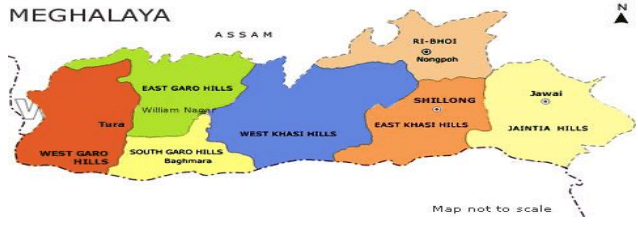
GNLA:
- The GNLA is largely a home-grown insurgent force in the state.
- It sustains by extortions and smuggling activities which can be contained with better deployment of the available force and with support from the local people.
- It was formed in 2009 is fighting for a 'sovereign Garoland' in the Western areas of Meghalaya.
- It has links with other militant outfits like ULFA and NDBF. It was involved in violence against security forces last year.
HNLC:
- It is a militant organization operating in Meghalaya, India.
- It claims to be a representative of the Khasi-Jaintia tribal people, and its aim is to free the Meghalaya from the alleged domination of the Garos and the non-tribal outsiders
Recent Development:
- A holistic appraisal of the internal security environment in the seven North-Eastern States, excluding Sikkim, shows that Meghalaya is relatively better placed.
- On November 2, 2015, the Meghalaya High Court issued a suo moto Order directing the Government of India to consider promulgation of the Armed Forces Special Powers Act (AFSPA) in the Garo Hills region of the State.
- This was delivered in the context of the Court’s negative perception of the internal security milieu in the southern parts of the State, particularly in the South-West, South, West and East Garo Hills districts, and regions bordering Bangladesh.
- The High Court has cited various recent instances of widespread lawlessness in the region including extortions and kidnappings by Garo National Liberation Army (GNLA) insurgents.
- The same Court had taken a forthright stand on similar subversive activities by another insurgent group – the Hynniewtrep National Liberation Council (HNLC), which, though presently subdued, has been trying to make its presence felt in the Khasi and Jaintia Hill districts of the State.
- In an Interim Order issued on May 27 2015, the Court had directed the State Government to restrain themedia from publicising statements or calls of bandh issued by the HNLC, so that the fundamental rights of the citizens guaranteed under the Constitution are not jeopardised. The Court had threatened to initiate ‘contempt of court’ proceedings against authorities and organisations which fail to uphold its
Order. The Court pointed out that HNLC was carrying on its activities inimical to the State and its people, despite being proscribed till November 2019 under the Unlawful Activities (Prevention) Act, and confirmation in this respect by the relevant Tribunal on May 25, 2015. - But the worrisome part is the low-key approach of the established political parties towards the insurgents, and the politician-middlemen-contractor nexus at the district level in siphoning off funds allotted under various development schemes. This nexus is breeding corruption and also distorting the visibility of many of the Central schemes among the common people. Often projects undertaken under such schemes are made to appear as though they are being sanctioned at the behest of the local politicians.
- Strengthening of social audit could lead to greater public awareness about the role of the state in promoting development and welfare of the people to counteract the insurgents.
Arunachal Pradesh:
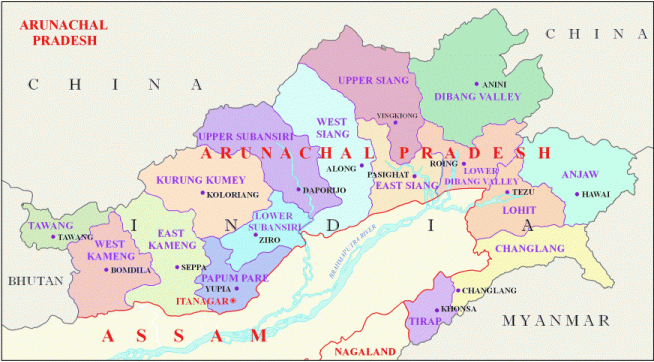
- Arunachal Pradesh, spread over 83,743 square kilometres in north-eastern India , was hailed until recently as the abode of peace. However, the State is gradually being afflicted by insurgency. Neither the State government nor the Centre have taken stock of the situation, nor drawn up an action plan to arrest the downslide
- The only case of indigenous insurgency movement in Arunachal Pradesh was the rise of the Arunachal Dragon Force (ADF), which was rechristened as East India Liberation Front (EALF) in 2001. The outfit remained active in the Lohit district, before being neutralised by the state police forces.
- Indigenous insurgency movements have only been a fraction of the problem that Arunachal Pradesh has come to encounter in the past years.
- A variety of factors including its geographical contiguity with Myanmar and ethnic similarities among the residents in some of Arunachal Pradesh’s districts with the locals in Nagaland has been the reasons why insurgent outfits from Assam and Nagaland have exploited the State for their activities.
- Traditionally, the south-western districts of Tirap and Changlang, in the proximity of Nagaland, have been a happy hunting ground for both the factions of the National Socialist Council of Nagaland (NSCN).
- While the Khaplang faction (NSCN-K) made its first inroads into the virgin territory in the early 1990s, the NSCN-IM faction soon made its move and carved out separate areas of influence in the district.
- Arunachal Pradesh has also been used as a transit route by the United Liberation Front of Asom (ULFA). While the movement of the ULFA cadres between the easternmost districts of Assam and the outfit’s facilities in the Sagaing division in Myanmar through Arunachal Pradesh can be traced back to the late 1980s, the State’s strategic importance for the ULFA has grown manifold after the outfit’s December 2003 ouster from Bhutan, following a military crackdown. The outfit’s dependence on its 28th battalion headquartered in Myanmar, for its hit and run activities in Assam, has become almost irreversible.

- ULFA cadres traversing the Assam-Arunachal Pradesh and Myanmar route had set up transit camps and safe houses in the Manabhum Reserve Forest, spread over 1500 square kilometres in the Lohit district.
- There were also a few incidents which revealed a nexus between the militants and the politicians, like the arrest of a NSCN (IM) militant from the residence of a former Minister of Arunachal Pradesh in Itanagar. Instances of forceful recruitments of tribal youths by the militant organizations, especially NSCN-K were also found.
- In a Conference of Chief Ministers on internal security, held at New Delhi on August 17, 2009 and attended by the Prime Minister and the Home Minister, the Arunachal Pradesh government asked the Centre to seal the entire stretch of the 440-km-long India-Myanmar border along the state in order to check the movement of insurgent outfits.
Impact of insurgency:
The impact of insurgency on the State has been serious. According to intelligence sources, every government employee and businessman in Tirap is forced to pay nearly twenty-five per cent of his gross income as a tax for the Republic of Nagalim . In the districts of Tirap and Changalang, branches of the State Bank of India have been shut down after they were served with extortion notes by the NSCN-K. In 2001, the operations of the Oil India Limited in Changlang district were brought to a halt after the NSCN-IM demanded an amount of Rs. 60 lakhs (US$ 125,000). The oil major had to pull out 130 of its technical staff from the area.
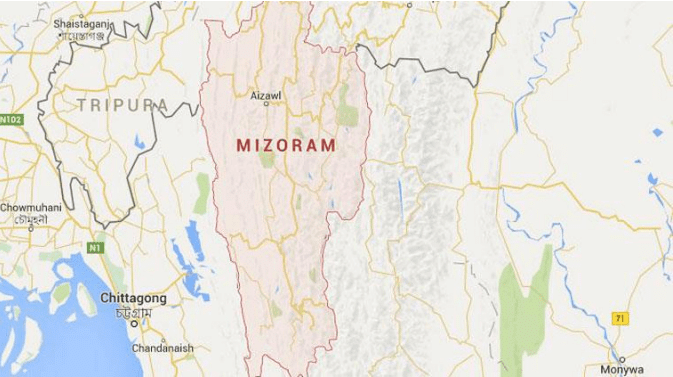
Mizoram:
- A situation similar to Nagaland developed a few years later in autonomous Mizo district of the Northeast. Sessionist demand backed by some British officials had grown there in 147 but had failed to get mush support from the youthful population. However, unhappiness with the Assam government’s relief measure during famine of 1959 and the passage of the Act in 1961, making Assamese the official language of the state, led to the formation of Mizo National Front (MNF),with Laldenga as president.
- While participating in the elections MNF created a military wing which received arms and ammunition and military support from East Pakistan and China. In March 1966 MNF declared independence from India, proclaimed a military uprising. The GOI responded with immediate massive counter insurgency measures by the army. Within a few weeks insurgency was crushed and government control was restored.
- In 1973, after the less extremist Mizo leaders has scaled down their demand to that of a separate state of Mizoram within the Indian Union, Mizo district of Assam was separated from Assam and, as Mizoram was given the status of a Union Territory.
- Mizo insurgency gained some renewed strength in the late 1970’s but was again effectively dealt with the Indian armed forces.
- A settlement was finally reached in 1986.An ‘accord’ was signed between the Union Government and the Mizo National Front in 1986 ,according to which insurgents group agreed to surrender before the Union and re-enter the constitutional political stream. A year later, statehood was conferred. Since the MNF has a formidable political force in the state.
Hmar insurgency
Not satisfied with the Mizo Accord of 1986 that ended two decades of insurgency led by the Mizo National Front (the peace deal did not grant the Hmar tribe administrative autonomy), some Hmar leaders formed the Hmar People’s Convention (HPC), and began a struggle for autonomy. The insurgency raged until 1994, when the Mizoram government set up the Sinlung Hills Development Council for Hmar-inhabited areas. The HPC joined the political mainstream, but Mizoram police and politicians say their best weapons were never surrendered, and an offshoot — the Hmar People’s Convention Democrats (HPCD) — emerged almost immediately and pressed on with the old demands.
Who are Hmar?
They are a tribal people living in Assam, Mizoram and Manipur, mainly in the area where these states meet. Although the Hmar identity is strong, Mizos in general consider them as part of the community, or at least as one of tribes that make up the Zohnahthlak, a loose grouping of tribes with largely similar customs, dialects and dress who live in Mizoram or its immediate vicinity. Many Hmars are members of Mizoram’s middle class; most no longer speak the Hmar dialect, and are fully integrated into Mizo society. In Manipur, the tribe is sometimes loosely included in the Kuki group, evidenced from the fact that one of the main Hmar armed groups — the HPCD — is considered part of the “Kuki armed groups” (more specifically, the United People’s Front group of militants).
Demands of the Hmar Insurgents:
The HPCD’s stated demand is a separate tribal autonomous district, and sometimes a state called Hmar Ram, for the Hmar tribe.
It suffers from two main weaknesses:
- The outfit is largely based in Manipur and a corner of southern Assam and has only thin physical presence in Mizoram
- There are two HPCD factions
Maoist Consolidation in North East:
- The Maoists have been able to extend the red corridor to the Northeast.
- The arrests of various top Maoist leaders in this region during 2013 revealed the extent of Maoist infiltration in Northeast India.
- Though at present they are restricted to certain pockets of this region, like along the Assam‐Arunachal Pradesh border areas, there is every possibility that they can extend their influence further in 2015.
- The Maoist rebellion in Northeast India is at present in its latent phase. The ‘latent phase’ involves mobilization of the masses, political awakening, visiting villages, engaging in small struggles on local issues, picking up students’ issues, fighting corruption, short–listing shelter and arms dumps and identification of local militant elements. This exactly is what the Maoists in Northeast India are doing at present.
- But this phase may soon pass away. With the arrested Maoist leaders already revealing that they were in touch with youths from Meghalaya and they being able to create a support base in the districts of Goalpara, Bongaigaon, Silchar, Karimganj and Kamrup in Assam12, it is a possibility that the Maoists may be able to consolidate their presence further in the region during 2015 and we may see the Maoists begin to engage in violent activities against the state machinery.
 |
Download the notes
Insurgency in North-East- 2
|
Download as PDF |
Spread of Islamist Militancy:
- Northeast India, shares an 1880 km long porous border with Bangladesh, a country that is a hotbed of Islamist militancy.
- Though radical Islam has not yet seeped into the Muslim population in the region, the arrests of twelve persons in Assam during November‐December 2014 with links with the Islamist terror outfit Jamaat‐ul‐Mujahideen Bangladesh (JMB) shows that radicalization of a section of Muslim population has begun in the region.
- The arrested persons have confessed that JMB was eyeing pockets inhabited by people of Bangladesh origin as well as districts like Sivasagar in eastern Assam, where it is said to have motivated some people.
- Though Islamist militancy is yet to find a root in Northeast, we may see efforts from Islamists to spread radical Islam among the Muslim population in the region in 2015.
- With low levels of development and lack of access to proper education and healthcare services in various parts of the region, especially in the Muslim‐dominated Char or riverine areas of Assam, fundamentalists may try to lure people towards their fold using these issues.
Security of India’s Northeast: External Linkage:
Introduction:
- Many ethnic groups in the region especially in the areas bordering the international boundaries have more in common with the population living across the boundary than with their own nationals. The affinity of groups with their kin groups across the border and the sense of support (both material and non material) they derive from them, have had serious implications. The social continuities that stretch across the territorial frontiers have led to demands by the politically fragmented groups to redraw international boundaries and also to reorganise states within the Indian Union.1 In many cases due to external manipulations and support, these fragmented ethno-political groupings have taken to arms and have adopted a line of confrontation with the state and central administration. The scope for resolution of conflicts at the internal level has been affected by such external involvement. This has had tremendous impact on the overall security situation in India. This paper seeks to throw light on the external coordinates of the conflicts in the northeast.
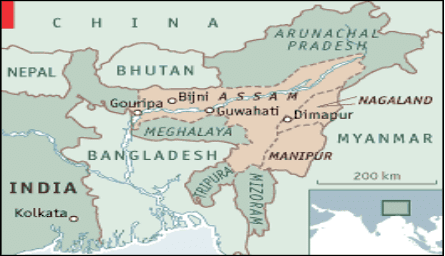
- Countries surrounding India have been active in exploiting the volatile situation presented by the turmoil in the northeast. Not only countries such as China, Pakistan, Bangladesh and Myanmar, but also smaller powers such as Bhutan and Nepal have been involved in the region. Through political backing, economic assistance, logistic support, military training or arms supplies these countries have varyingly contributed to the ongoing violence in this region.
China:
- Northeastern India is inhabited by Mongoloid tribes who have close ethnic and cultural ties with the tribes in China, Tibet and Burma. Barring Khasis and Jaintias of Meghalaya, almost all hill tribes belong to the Tibeto-Chinese fold and to the Tibeto-Burmese family.
- It was this feeling of affinity towards the border people of erstwhile East Pakistan and Burma that led some of these tribal groups to turn towards their own stock rather than towards the country they resided in.
- The strategic location of the northeast and the access of the disaffected groups to China, Bangladesh, Myanmar, Bhutan and Nepal, together with material and moral support of foreign intelligence agencies to these groups, have facilitated insurgency in the northeast region.
- Among these, the Chinese support to insurgents in the northeast came early in the 1960s and continued through the 1970s. In May 1966, the Nagas approached Peoples’ Republic of China for ‘any possible assistance’.
- It was in Yunan that the Naga fighters were imparted with the knowledge of arms and guerrilla tactics and they were also taught Maoism.
- With the Chinese support the Naga insurgency became stronger and more intense with better tactics and modern weapons.
- Apart from the Nagas, the Chinese also extended moral and material support to the Mizo and Meiti insurgents by arranging for their training in guerilla warfare and subversion in training centres in Yunan province of mainland China.and Lhasa in Tibet.
- The Chinese People’s Liberation Army (PLA) was busy building an unmetalled road track heading towards the Line of Actual Control (LAC) across Arunachal Pradesh even as the joint working group was trying to thrash out solutions to the lingering border dispute.
- The Chinese in their endeavour to normalise relations with India have been assuring New Delhi that they have stopped all aid to the insurgents in the northeast.
- It has been discouraging insurgent groups from trekking to China for receiving instruction in guerilla tactics.12 Pakistani analysts have taken this policy change as a shift in China’s position in South Asia.
- They have written that ‘from a policy of granting open support to Pakistan vis-a-vis India during the 1960s and 1970s, China’s strategic priorities changed in South Asia during 1980s and 1990s. From an active hostile relationship with India, China changed its India’s policy to passive hostility and finally neutrality". Nevertheless, India is yet to be convinced about Chinese intentions.
Bhutan:
- Given India’s porous borders with Bhutan, the militant groups from Assam have very often sought refuge in Bhutanese territory.
- In 1990 India launched Operations Rhino and Bajrang against Assamese separatist groups. Facing continuous pressure, Assamese militants relocated their camps to Bhutan.
- It has proved really difficult on the part of the security forces to handle these forces operating from Bhutan. At least 4,000 cadres of the outlawed United Liberation Front of Asom (ULFA) and more than a thousand tribal Bodo militants from Assam are estimated to have crossed the borders and are based in camps in southern Bhutan.
- Bhutan has cooperated with India in uprooting the militant groups from its soil.
- Operation All Clear was a military operation conducted by Royal Bhutan Army forces against Assam separatist insurgent groups in the southern regions of Bhutan between 15 December 2003 and 3 January 2004. It was the first operation ever conducted by the Royal Bhutan Army.
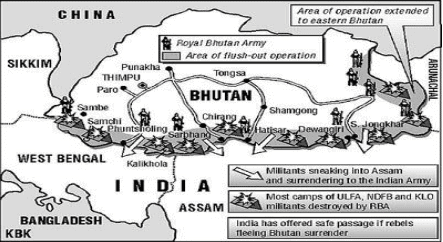
- Sustained action by Bhutan against groups like ULFA, NDBF, BLTF etc. has eliminated their support and operations from Bhutan.
- Recently in 2015, Bhutan has assured India that it will soon launch an operation to flush out anti-India insurgents — active in West Bengal and northeastern states — operating from its territory. Bhutan is expected to launch anti-terror operations in the next couple of months to flush out cadres of Kamtapur Liberation Organisation (KLO) and northeastern insurgent groups operating from southern Bhutan. India had shared this information with Bhutan and urged action against the insurgents.
Nepal:
- Nepal is acting as the safest entry point for intelligence operations unleashed by Pakistani intelligence against India.
- The fact that Nepal was being used as a corridor to smuggle in ISI agents has been established after the tracking down of Yakoob Memon, one of the accused in the Bombay Blast case in 1996 from Kathmandu.
- The hijacking of an Indian aircraft from Kathmandu revealed the dangerous face of cross-border intelligence activities targeted at Indian national security.
- Many of the ISI agents have found the Nepal route safe to enter into northern India and then spread out to the northeast and other regions.
- It is also a conduit of counterfeit Indian currency.
- ISI agents operating from Nepal has been a point of serious concern for New Delhi as the militants have been taking advantage of the 1,800 km porous IndoNepal border in fomenting trouble in various parts of India.
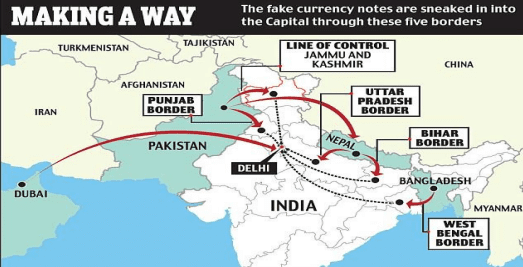
- Nepal has co-operated with India in carrying out covert operations in targeting any anti-Indian activity on its soil.
Bangladesh:
- East Pakistan, Bangladesh since 1971 was host to many insurgent activities unleashed against India in the northeastern region.
- With the emergence of Bangladesh, the tribal insurgents operating under Pakistani intelligence cover within East Pakistan suffered a setback.
- The status quo was maintained till Sheikh Mujib’s regime was pulled down. Immediately after the assassination of Mujibur Rehaman, the new regime allowed the Mizo insurgents to establish their bases in Chittagong Hill Tracts.
- various Bangladeshi governments till the present one headed by Ms. Sheikh Hasina had allowed Pakistan Intelligence operatives to launch their anti-India activities from Bangladeshi soil. In most of the cases the government turned a blind eye to the ISI operations inside Bangladesh. This has facilitated the ISI channelization of money and materials through Bangladesh to insurgent groups in the northeast.
- The anti-India operations have been largely possible because of the presence of an overwhelming illegal immigrant Bangladeshi population in the northeast. The porosity of the Indo-Bangladesh border has led to many unanticipated problems for India.42 The porous border between Indian states of Assam, West Bengal and Bangladesh has led to the smuggling of jute, rice and other commodities. Smuggling in itself is not a problem but it is symptomatic of the difficulties in the relations of the two states.43 As the entire Indo-Bangladesh border is porous and prone to large-scale illegal immigration, infiltration and smuggling from Bangladesh, the Centre had sanctioned work on the Indo-Bangla border roads and fencing project in 1986. This has not been completed as yet.
- Due to the porosity of the borders, the northeast has also become a hotspot for large-scale migration across the borders. The ethnic affinities that cut across the boundaries have traditionally facilitated the movement of people from poor states to richer neighbours.44 India has been the victim of large-scale inmigration from bordering countries. Its booming economy, liberal democratic society and ethno-cultural commonality with the bordering states has encouraged people from the neighbourhood to migrate to India. This population has been the prime target of the Pakistani intelligence in every likelihood. Moreover, the local population within India has treated these migrants as unacceptable aliens. This has added to the complexity of the problem in the northeastern region.
- The resentment over the increase in the number of Chakmas in Mizoram is another cause for worry. Mizos allege that a large number of Chakmas from Chittagong Hill Tracts (CHT) region of Bangladesh have settled in the Chakma Autonomous District Council in the state. Again, the tribal-outsider dichotomy has generated violence in Meghalaya, Tripura and Assam, thus leading to a silent outmigration of the non-tribal population from these states.
- Apart from assisting insurgent groups in northeast India, Bangladesh is being increasingly used for smuggling ISI agents into India through its porous borders with West Bengal, as Nepal is used for sending them into North India, particularly Uttar Pradesh. Meanwhile, the ISI’s operations have spread to other parts of India like Delhi, Uttar Pradesh, Rajasthan, West Bengal, Andhra Pradesh, Tamil Nadu and Maharashtra.
- Media reports suggest that the outlawed United Liberation Front of Asom (ULFA) has started several lucrative income-generating projects in Bangladesh to sustain its anti-India activities in this country. These include three hotels, a private clinic and two motor driving schools in Dhaka, a number of grocery and drug stores in Sylhet, poultry farms in Mymensingh, and two schools in Narsingdi.
- Current government of Bangladesh has been very keen in improving relations with India. The Government has been cooperating with Indian Intelligence in flushing out militants in its territory. It has arrested many terrorists of ULFA, NSCN, BNDFetc and deported them to India.
- Signing of LBA will address the issue of porous border and related smuggling of arms and drugs and infiltration.
- However, illegal migration from Bangladesh continues to pose a challenge to internal security which needs to be addressed by our neighbor.
- India Bangladesh signed a historic boundary agreement in 2015.
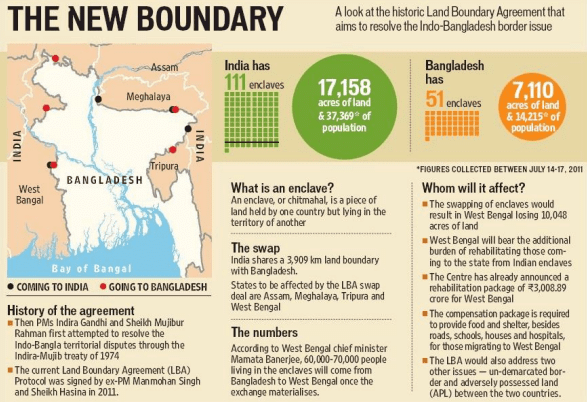
Myanmar:
- India shares a 1670 km long land border and a maritime border of 200 km with Myanmar.
- The present day population along the India-Myanmar border has a strong socio-cultural affinity, which is the outcome of a long historical process of intermingling among the people of the area. They belong to the Tibeto Burmese stock and trace their origin to the east i.e. through Burma or from Burma.
- The Indo-Myanmar border remains comparatively peaceful and there is no remarkable border conflict between the two countries. However, the separatist feeling and legacy of discontent among the various tribes straddling the borders still survives.
- Many northeastern insurgent groups, like the Nagas, the Mizos and the Meitis, had bases in Burma as well.
- During mid-1966 NNC established contact with the Kachin Independence Army in the Kachin Hill tracts of Burma. The Mizos and Tripuris were also able to establish links with the Burmese insurgents and found safe sanctuaries in the lightly administered border areas of Burma.
- Some Burmese tribals belonging to the Kuki Chin Group are fighting for merger of lands in habitated by them with India.The underground Zomi Liberation Front in Myanmar used to recruit cadres for guerilla warfare against Myanmar. After the crackdown on pro-democracy supporters, many of these have sought shelter in Manipur and Mizoram.
- Apart from the question of promotion of border trade India and Mayanmar have agreed to check movement of militants across the border. They also agreed to strengthen communication networks along the international border.
- Moreover, the two sides have also agreed to step up measures to check narcotics smuggling across the Indo-Myanmar border.
- The two sides have also discussed the possibility of launching joint operations against the militants operating out of Myanmar, the last joint operation code named ‘Operation Golden Bird’ was very successful and it dealt a heavy blow to ULFA.
- Given that the vulnerability of the India-Myanmar border is posing a serious challenge to the internal security of the country, the Government of India should pay immediate attention to effectively manage this border.
Way Forward
Although varying in their demands and methods, there is a common thread running through the insurgency infested north-east, that is of identity and development. Hence, some solutions that are common need to be explored with specifics derived from them for specific regions and groups.
- Meeting the political aspirations of groups by giving them autonomy. Implementing sixth schedule provisions in these areas will help them to preserve their identity and culture while giving them greater autonomy.
- Economic development of the area in a calibrated manner. Any development should be sustainable and should have the participation and acceptance by the locals.
- Improving Governance and delivery mechanisms of the government and administration.
- The pre-condition of complete abjuring of violence for holding peace talks is a flawed notion. If violence is discarded and peace is established then the need of peace talks become futile. Dialogue should be ongoing process to reach concrete solutions by involving all the stakeholders and not a single group.
- Coordinating operations with the neighboring countries and use of force only when needed. Draconian laws like AFSPA should be repealed as it is one of the causes for inflating insurgency in north east.
- Rebel groups must also be more pragmatic by seeking greater autonomy within the constitutional mandate rather than demanding newer states and regions based on ever narrowing ethnic and linguistic identities, which are beyond acceptance.
- Centre and states should coordinate in decision making. In the recent agreement of the Centre with NSCN (IM), it did not take concerned state governments and other groups on board. It should be avoided.
- State police and central forces should cooperate on intelligence sharing, investigation and operations against militants. It has been alleged by the army that the June ambush of the army became possible because state police did not share the intelligence about the attack with it. It is unfortunate and counter-productive.
|
1090 videos|2974 docs|1354 tests
|























